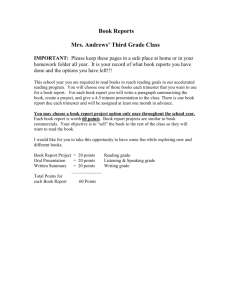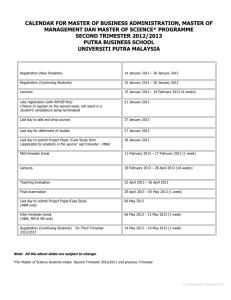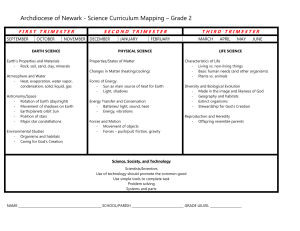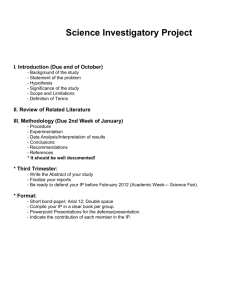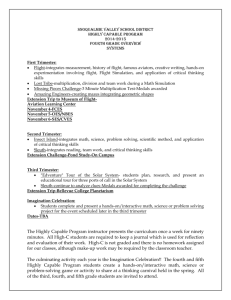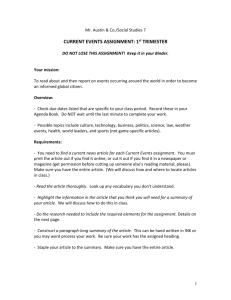1st Grade Math Essential Standards
advertisement
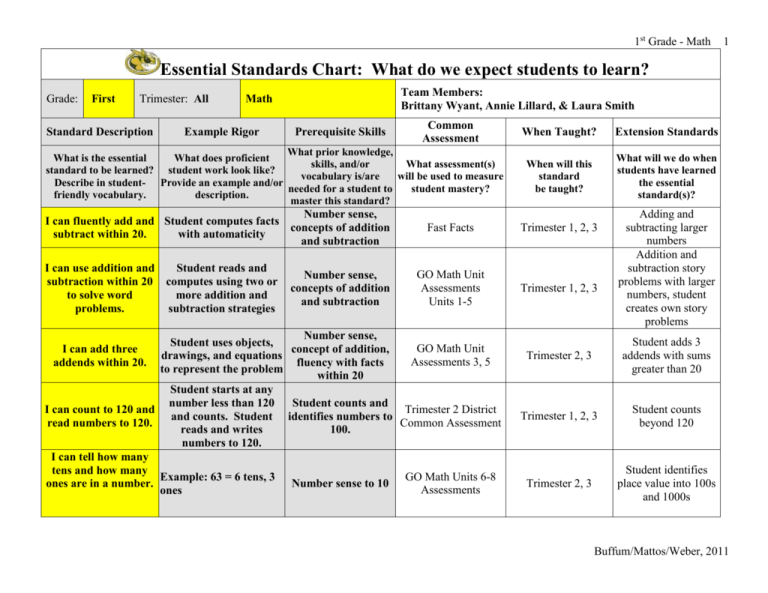
1st Grade - Math 1 Essential Standards Chart: What do we expect students to learn? Grade: First Trimester: All Standard Description Team Members: Brittany Wyant, Annie Lillard, & Laura Smith Math Example Rigor Prerequisite Skills Common Assessment What prior knowledge, What is the essential What does proficient skills, and/or What assessment(s) standard to be learned? student work look like? vocabulary is/are will be used to measure Describe in student- Provide an example and/or needed for a student to student mastery? friendly vocabulary. description. master this standard? Number sense, I can fluently add and Student computes facts concepts of addition subtract within 20. with automaticity and subtraction I can use addition and Student reads and subtraction within 20 computes using two or to solve word more addition and problems. subtraction strategies Number sense, concepts of addition and subtraction When Taught? Extension Standards When will this standard be taught? What will we do when students have learned the essential standard(s)? Fast Facts Trimester 1, 2, 3 GO Math Unit Assessments Units 1-5 Trimester 1, 2, 3 Number sense, Student uses objects, GO Math Unit I can add three concept of addition, drawings, and equations Assessments 3, 5 addends within 20. fluency with facts to represent the problem within 20 Student starts at any number less than 120 Student counts and Trimester 2 District I can count to 120 and and counts. Student identifies numbers to Common Assessment read numbers to 120. reads and writes 100. numbers to 120. I can tell how many tens and how many GO Math Units 6-8 Example: 63 = 6 tens, 3 ones are in a number. Number sense to 10 Assessments ones Adding and subtracting larger numbers Addition and subtraction story problems with larger numbers, student creates own story problems Trimester 2, 3 Student adds 3 addends with sums greater than 20 Trimester 1, 2, 3 Student counts beyond 120 Trimester 2, 3 Student identifies place value into 100s and 1000s Buffum/Mattos/Weber, 2011 1st Grade - Math Example: What goes in I can compare the box to make this Place value of ones numbers within 100 by problem correct? and tens using symbols <, >, =. 62 ___ 64 < > = I can use models or Place value of ones drawings to add a two45 and tens, addition digit number and a +3 facts to 20 one-digit number. I can find 10 more and 74 Place value of ones 10 less than a two-digit 84 and tens, meaning of number. 94 a ten _____________ Vocabulary: longer, I can order three _________ shorter, more of, less objects by length. ____ of I can measure the length of an object with unit cubes. I can tell and write time to the hour and half hour using digital and analog clocks I can organize, represent, and interpret data with up to three categories. I can name 2D and 3D shapes. ______________ 10 0 Series 1 Series 2 Vocabulary: units, length, longer, shorter Number sense, count by 5s, concept of clockwise, minute and hour hand Number sense, concept of a survey, how to categorize, more than, less than Triangle, rectangle, square, circle, half circle, trapezoid, quarter circle GO Math Unit 7 Trimester 3 GO Math Unit 7 Trimester 2, 3 GO Math Unit 9 GO Math Unit 9 Student compares larger numbers and inequalities Trimester 2 GO Math Unit 8 Student uses regrouping in symbolic form to add two digit numbers Student can find 10 more and 10 less than 3 digit numbers. Trimester 3 Student can order more than 3 objects by length. Trimester 3 Student can measure the length of an object using standard units. Student tells time to 5 minutes. Go Math Unit 9 Trimester 3 GO Math Unit 10 Trimesters 2 & 3 Student asks and answers questions about data. Trimester 3 Student composes composite 2D and 3D shapes. Student partitions shapes into halves and fourths. GO Math Unit 2 Buffum/Mattos/Weber, 2011
